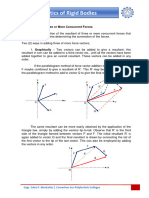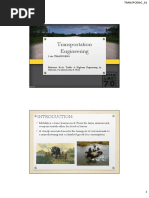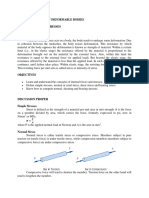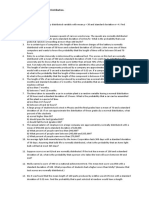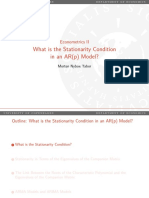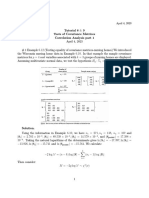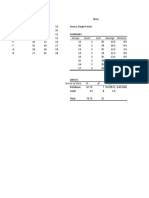Problem 3
Uploaded by
Cường NguyễnProblem 3
Uploaded by
Cường NguyễnProblem 3.27: Problem content: An assembly consists of three mechanical components.
Suppose that the probabilities that the first, second, and third components meet specifications are 0.95, 0.98, and 0.99. Assume that the components are independent. Determine the probability mass function of the number of components in the assembly that meet specifications. Solution: According to the problem content, let is the probability that component is meet specifications then = 1 - is the probability that component is not meet specifications. We have 3 components so we have stand for the first, second and third components. So then:
Table 1: Probability
Let is the event that component is meet specifications. Then is the event that component is not meet specifications. With Then we have the possible outcomes table: Event Probabilities NOC
*NOC: Number of components meets specification Table 2: Possible outcomes and probabilities
Let the random variable denote the number of components that meet specifications. Then, can assume any of integer values 0 through 3. Let denote the measured value of . Then Let and is the probability mass function of , is the probability of with is the cumulative distribution function of
According to Table 2, we have: Probability to have 0 component meets specification: Probability to have 1 component meets specification: Probability to have 2 components meets specification: Probability to have 3 components meets specification:
Then we have the probability mass function:
And the cumulative distributions function:
Means (expected values): Variance values
You might also like
- Introduction To Ihstat Software: (Required For Assignment 3)100% (1)Introduction To Ihstat Software: (Required For Assignment 3)15 pages
- Equilibrium: This Module Aims That The Students Will Be Able ToNo ratings yetEquilibrium: This Module Aims That The Students Will Be Able To12 pages
- For Which The Crate in The Prob. 3.6 Will Be In: Chapter Three EquilibriumNo ratings yetFor Which The Crate in The Prob. 3.6 Will Be In: Chapter Three Equilibrium9 pages
- Simple Curves - Surveying and Transportation EngineeringNo ratings yetSimple Curves - Surveying and Transportation Engineering7 pages
- Module 3 (Resultant of Cocurrent Fore Systems)No ratings yetModule 3 (Resultant of Cocurrent Fore Systems)11 pages
- Analytic Geometry: PATTS College of AeronauticsNo ratings yetAnalytic Geometry: PATTS College of Aeronautics12 pages
- L01 - Introduction & Spot Speed StudiesNo ratings yetL01 - Introduction & Spot Speed Studies26 pages
- Structural Theory - Part 2b - Illustrative ProblemsNo ratings yetStructural Theory - Part 2b - Illustrative Problems14 pages
- Problems: Centroids and Distributed LoadsNo ratings yetProblems: Centroids and Distributed Loads5 pages
- MODULE 1 in Math 221 - Numerical Solutions To CE Problems 222jNo ratings yetMODULE 1 in Math 221 - Numerical Solutions To CE Problems 222j83 pages
- Differential Equations:: Cagayan State University-Carig CampusNo ratings yetDifferential Equations:: Cagayan State University-Carig Campus5 pages
- With Solutions MATH22 - Engineering Data Analysis Module 3No ratings yetWith Solutions MATH22 - Engineering Data Analysis Module 329 pages
- Polytechnic University of The Philippines: ENSC 20043 Statics of Rigid Bodies Quiz 2No ratings yetPolytechnic University of The Philippines: ENSC 20043 Statics of Rigid Bodies Quiz 23 pages
- Solutions To Practice Problems, Module 1: Engineering Mechanics100% (1)Solutions To Practice Problems, Module 1: Engineering Mechanics13 pages
- Dependent Motions - : Dynamics of Rigid BodiesNo ratings yetDependent Motions - : Dynamics of Rigid Bodies22 pages
- Experiment 7 Electric Field Data Sheet Group 1 June 8No ratings yetExperiment 7 Electric Field Data Sheet Group 1 June 86 pages
- Mechanics of Deformable Bodies Module 1No ratings yetMechanics of Deformable Bodies Module 115 pages
- 2.3.b MEASUREMENT OF DISTANCE BY TAPINGNo ratings yet2.3.b MEASUREMENT OF DISTANCE BY TAPING45 pages
- COPLANAR EQUILIBRIUM ANALYSIS Single and Composite BodiesNo ratings yetCOPLANAR EQUILIBRIUM ANALYSIS Single and Composite Bodies49 pages
- Exercise 113 Further Problems On Solving Simultaneous Equations Using MatricesNo ratings yetExercise 113 Further Problems On Solving Simultaneous Equations Using Matrices5 pages
- Dokumen - Tips - Simple Stresses From MathalinoNo ratings yetDokumen - Tips - Simple Stresses From Mathalino58 pages
- Solution To Problem 128 Bearing Stress - Strength of Materials Review at MATHaliNo ratings yetSolution To Problem 128 Bearing Stress - Strength of Materials Review at MATHali7 pages
- Project For Module 2 - Problem Set With SolutionNo ratings yetProject For Module 2 - Problem Set With Solution22 pages
- Toaz - Info Mechanics Problems Amp Solutions PRNo ratings yetToaz - Info Mechanics Problems Amp Solutions PR41 pages
- Chapter09 E-Commerce Security and Fraud Protection 10100% (1)Chapter09 E-Commerce Security and Fraud Protection 1072 pages
- Chapter11 Order Fulfillment Along The Supply ChainNo ratings yetChapter11 Order Fulfillment Along The Supply Chain33 pages
- Chapter14 E-Commerce Regulatory-Ethical-And Social Environments 13No ratings yetChapter14 E-Commerce Regulatory-Ethical-And Social Environments 1338 pages
- Chapter02 E-Commerce Mechanisms Infrastructures Tools100% (1)Chapter02 E-Commerce Mechanisms Infrastructures Tools55 pages
- Chapter10 Electronic Commerce Payment Systems 10No ratings yetChapter10 Electronic Commerce Payment Systems 1027 pages
- Download A beginner s guide to structural equation modeling 3rd Edition Randall E. Schumacker ebook All Chapters PDF100% (1)Download A beginner s guide to structural equation modeling 3rd Edition Randall E. Schumacker ebook All Chapters PDF86 pages
- Practice Questions MGT 632: Business Research Methods/ MGB 114: Research MethodsNo ratings yetPractice Questions MGT 632: Business Research Methods/ MGB 114: Research Methods9 pages
- Ch-4 Processor Memory Modeling Using Queuing Theory100% (2)Ch-4 Processor Memory Modeling Using Queuing Theory19 pages
- CampusX Data Science Mentorship Program CurriculumNo ratings yetCampusX Data Science Mentorship Program Curriculum40 pages
- One Sample T Test - SPSS Tutorials - LibGuides at Kent State UniversityNo ratings yetOne Sample T Test - SPSS Tutorials - LibGuides at Kent State University10 pages











